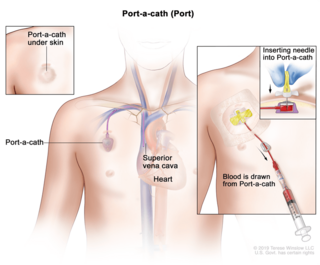Patient Instructions: Caring for a Port at Home
These instructions are for Children’s Hospital of Philadelphia (CHOP) patients going home with an implantable venous port.

Important information about the port:
- Learn more about an implantable venous port.
- To give medicines or take blood using the port, a nurse will access your child’s port. “Accessing a port” means that a special type of needle is being placed through the skin and into the middle of the port. Your child will feel some discomfort when the needle is placed.
- We can apply a cream, called Emla or LMX4, to numb the skin so that the needle won’t hurt as much.
- If your child needs medicine to go into the port for long periods of time, the needle will remain in the port and a dressing will be placed over it.
- If the port is not used, it will be flushed once a month with heparin to prevent blood from clotting the catheter. This can be done at home, or during a clinic visit. No dressing is needed over the port if it is not being used.
- The port stays in as long as your child needs a way to get medicine into their bloodstream. When the port is no longer needed, the surgeon will usually remove it in the operating room.
- If you need to flush the port at home or use the port to give your child medicine at home, a nurse will teach you and another caregiver how to do this.
Instructions for going home after port placement:
- For the first few days after the port is placed, there will be Steri-Strip™ bandages or stitches at the incision. Do not submerge the Steri-Strips™ under water. They will fall off by themselves.
- You may gently clean the area with mild soap and water after the Steri-Strips™ fall off.
- If stitches were used, the healthcare provider will take them out 1 to 2 weeks after surgery. Once healed, clean the area daily with soap and water. Your child may take a bath or shower.
- The port is completely under the skin, so it does not need special care if it is not being used. It is very important for you to examine the skin over and around the port often.
- For the first 5-7 days after receiving the port, your child should avoid rough activities. After the incision is well healed, your child may resume normal activities. Contact sports should be avoided unless you have special permission from your child’s doctor.
Call your CHOP healthcare team with any questions or concerns, or if you see any signs of infection, such as:
- Fever (your healthcare team will tell you what they consider to be a fever for your child)
- Redness
- Swelling
- Blotchy skin color
- Soreness (after the 1st week)
- Odor
- Itching
- Chills
- Shortness of breath
Call your CHOP healthcare team with any questions and as directed in these instructions:
Call the office of the healthcare provider or team who ordered the port to be placed:
8:30am-5:00pm, Monday – Friday:
Call that office
Evenings, nights, weekends, and holidays:
215-590-1000 and ask to speak to the Fellow on call for that specialty.
If your child is an oncology patient, call the CHOP oncology team:
If you have any questions about your child’s health, please contact your child’s healthcare provider. This document is intended only to provide general educational information and is not intended as medical advice or treatment. Please consult with your healthcare provider prior to use, as some of this information may need to be adapted for your child’s specific needs. It is the responsibility of your healthcare provider to advise you on the appropriate use of this information. If you/your child are not already a CHOP patient, this document does not create a doctor-patient relationship between you/your child and CHOP. CHOP is not responsible for any outcomes you/your child might experience from your use of this document. This document is provided "AS IS", WITHOUT WARRANTIES OR CONDITIONS OF ANY KIND, express or implied. If this document refers to any drugs or medical devices, it is the responsibility of your healthcare provider to check the FDA status prior to use. If this document includes references to drug dosing, please do not rely on this document. Your healthcare provider should check the package insert for each drug before use. Hyperlinks used within this document may not be translated into other languages.
©2022 Children’s Hospital of Philadelphia. Not to be copied or distributed without permission.